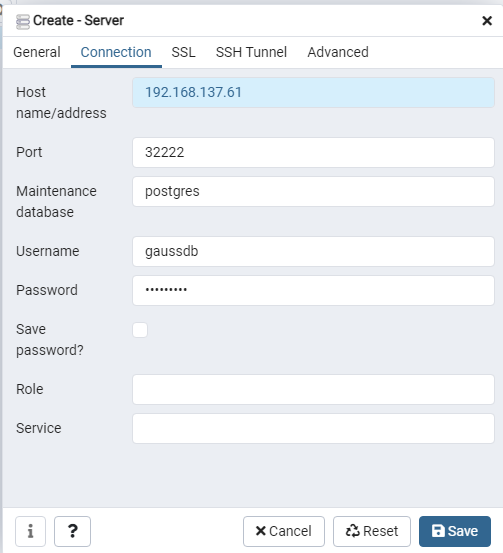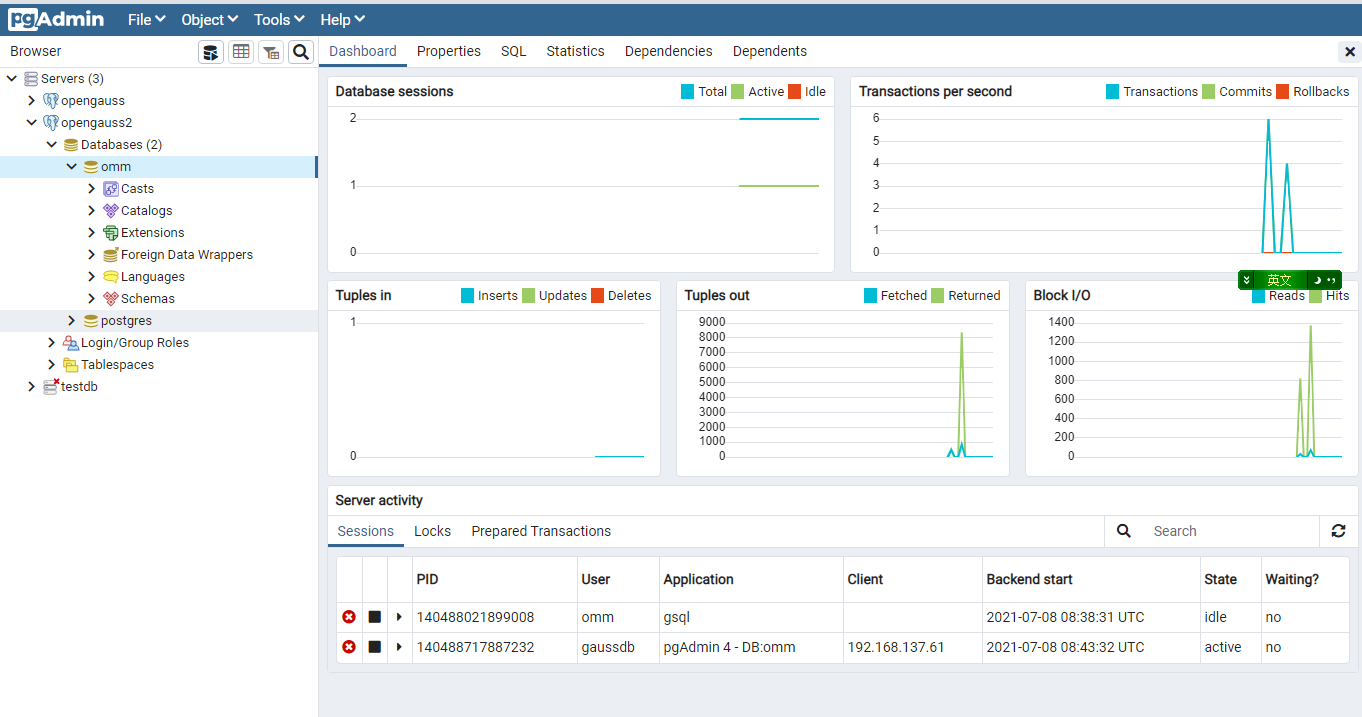openGauss
开源数据库
openGauss社区官网
开源社区
openGauss在kubernetes集群环境上的部署
2021-07-10openGauss在kubernetes集群环境上的部署
opengauss 实践总结学习心
openGauss 是一款开源关系型数据库管理系统 , 深度融合华为在数据库领域多年的经验,结合企业级场景需求,持续构建竞争力特性;kubernetes 也是一个开源的,用于管理云平台中多个主机上的容器化的应用,Kubernetes 的目标是让部署容器化的应用简单并且高效,Kubernetes 提供了应用部署,规划,更新,维护的一种机制, 本篇文章将介绍 openGauss 在 kubernetes 集群环境上的部署探索。
1.检查 k8s 运行环境
[root@n-k8s-m ~]# kubectl get node
>NAME STATUS ROLES AGE VERSION
n-k8s-m Ready master 349d v1.18.0
2.查看准备好的 openGauss 的 docker 镜像
[root@n-k8s-m ~]# docker images
REPOSITORY TAG IMAGE ID CREATED SIZE
nginx latest 4cdc5dd7eaad 36 hours ago 133MB
opengauss 2.0.0 757bf74560e3 5 weeks ago 639MB
3.安装 NFS 服务器存储
#安装依赖包
[root@n-k8s-m ~]#yum -y install nfs-utils rpcbind
#开机启动
[root@n-k8s-m ~]#systemctl enable rpcbind.service
[root@n-k8s-m ~]#systemctl enable nfs-server.service
[root@n-k8s-m ~]#systemctl start rpcbind.service #端口是111
[root@n-k8s-m ~]#systemctl start nfs-server.service # 端口是 2049
#配置NFS
[root@n-k8s-m ~]#mkdir /home/pv1
[root@n-k8s-m ~]#chown nfsnobody:nfsnobody /home/pv1
[root@n-k8s-m ~]#cat /etc/exports</p>
<pre><code class="lang-">/home/pv1 ***.***.***.***/24(rw,async,all_squash)
</code></pre>
<p>[root@n-k8s-m ~]#exportfs -rv</p>
<pre><code class="lang-">exporting ***.***.***.***/24:/home/pv1
</code></pre>
/home/pv1 ***.***.***.***/24(rw,async,all_squash)
>[root@n-k8s-m ~]#exportfs -rv
exporting ***.***.***.***/24:/home/pv1
4.创建 openGauss 所使用的存储 pv
#编写yaml文件
[root@n-k8s-m ~]# cat opengauss_pv.yml
apiVersion: v1
kind: PersistentVolume
metadata:
name: opengauss-pv
labels:
type: nfs001
spec:
capacity:
storage: 1Gi
accessModes:
- ReadWriteMany
persistentVolumeReclaimPolicy: Recycle
nfs:
path: "/home/pv1"
server: ***.***.***.*** readOnly: false
#创建pv
[root@n-k8s-m opengauss]# kubectl create -f opengauss_pv.yml
persistentvolume/opengauss-pv created
#查看创建pv
[root@n-k8s-m opengauss]# kubectl get pv
NAME CAPACITY ACCESS MODES RECLAIM POLICY STATUS CLAIM STORAGECLASS REASON AGE
opengauss-pv 1Gi RWX Recycle Available
5.创建 openGauss 所使用的存储 pvc
#编写yaml文件
[root@n-k8s-m ~]# cat opengauss_pvc.yml
apiVersion: v1
kind: PersistentVolumeClaim
metadata:
name: opengauss-pvc
spec:
accessModes:
- ReadWriteMany
resources:
requests:
storage: 1Gi
#创建pvc
[root@n-k8s-m opengauss]# kubectl create -f opengauss_pvc.yml
persistentvolumeclaim/opengauss-pv created
#查看创建pvc
[root@n-k8s-m opengauss]# kubectl get pvc
NAME STATUS VOLUME CAPACITY ACCESS MODES STORAGECLASS AGE
opengauss-pvc Bound opengauss-pv 1Gi RWX 4s
6.创建 openGauss 的 Deployment
#编写yaml文件
apiVersion: apps/v1
kind: Deployment
metadata:
name: opengauss-deployment
spec:
selector:
matchLabels:
app: opengauss
strategy:
type: Recreate
template:
metadata:
labels:
app: opengauss
spec:
containers:
- image: opengauss:2.0.0
name: opengauss-service
imagePullPolicy: IfNotPresent
env:
- name: GS_PASSWORD
value: ******
ports:
- containerPort: 5432
name: opengauss
volumeMounts: # 挂载Pod上的卷到容器
- name: opengauss-persistent-storage # Pod上卷的名字,与“volumes”名字匹配
mountPath: /var/lib/opengauss # 挂载的Pod的目录
volumes: # 挂载持久卷到Pod
- name: opengauss-persistent-storage # 持久卷名字, 与“volumMounts”名字匹配
persistentVolumeClaim:
claimName: opengauss-pvc # 持久卷申请名字
#创建Deployment[root@n-k8s-m opengauss]# kubectl create -f opengauss_deploy.yaml
deployment.apps/opengauss-deployment create
#查看创建Deploymen
[root@n-k8s-m opengauss]# kubectl get deploy
NAME READY UP-TO-DATE AVAILABLE AGEopengauss-deployment 1/1 1 1 110s
#创建Deployment
[root@n-k8s-m opengauss]# kubectl create -f opengauss_deploy.yaml
deployment.apps/opengauss-deployment created
#查看创建Deployment
[root@n-k8s-m opengauss]# kubectl get deploy
NAME READY UP-TO-DATE AVAILABLE AGE
opengauss-deployment 1/1 1 1 110s
7.创建 openGauss 的 Service 提供集群内部和外部的高可用访问
#编写yaml文件
apiVersion: v1
kind: Service
metadata:
name: opengauss-service
labels:
app: opengauss
spec:
type: NodePort
selector:
app: opengauss
ports:
- protocol : TCP
nodePort: 32222
port: 5432
targetPort: 5432
#创建openGauss的Service
[root@n-k8s-m opengauss]# kubectl create -f opengauss_svc.yaml
>service/opengauss-service created
#查看创建Service
[root@n-k8s-m opengauss]# kubectl get svc
NAME TYPE CLUSTER-IP EXTERNAL-IP PORT(S) AGE
opengauss-service NodePort 10.101.64.232 <none> 5432:32222/TCP 6s
8.连接 openGauss 数据库
#使用kubectl内部连接数据库
[root@n-k8s-m opengauss]# kubectl get pod
NAME READY STATUS RESTARTS AGE
opengauss-deployment-6b8b4645f8-bfk4w 1/1 Running 0 15m
[root@n-k8s-m opengauss]# kubectl exec -it opengauss-deployment-6b8b4645f8-bfk4w sh
kubectl exec [POD] [COMMAND] is DEPRECATED and will be removed in a future version. Use kubectl kubectl exec [POD] -- [COMMAND] instead.
sh-4.2# su - omm
[omm@opengauss-deployment-6b8b4645f8-bfk4w ~]$ gsql
gsql ((openGauss 2.0.0 build 78689da9) compiled at 2021-03-31 21:04:03 commit 0 last mr )
Non-SSL connection (SSL connection is recommended when requiring high-security)
Type "help" for help.
omm=# \c
Non-SSL connection (SSL connection is recommended when requiring high-security)
You are now connected to database "omm" as user "omm".
omm=# \l
List of databases
Name | Owner | Encoding | Collate | Ctype | Access privileges
-----------+-------+----------+------------+------------+-------------------
omm | omm | UTF8 | en_US.utf8 | en_US.utf8 |
postgres | omm | UTF8 | en_US.utf8 | en_US.utf8 |
template0 | omm | UTF8 | en_US.utf8 | en_US.utf8 | =c/omm +
| | | | | omm=CTc/omm
template1 | omm | UTF8 | en_US.utf8 | en_US.utf8 | =c/omm +
| | | | | omm=CTc/omm
(4 rows)
使用 pgadmin4 外部连接数据库

